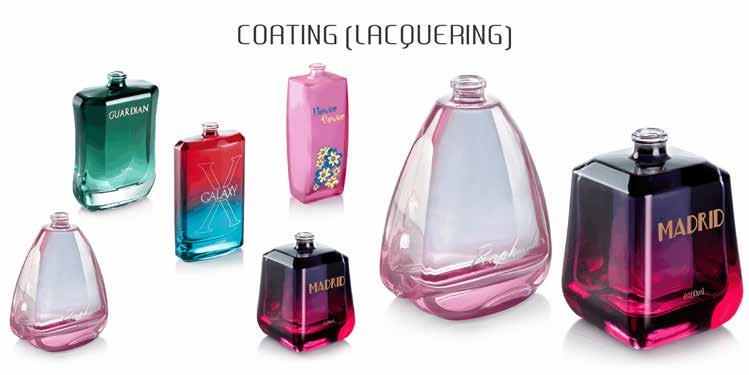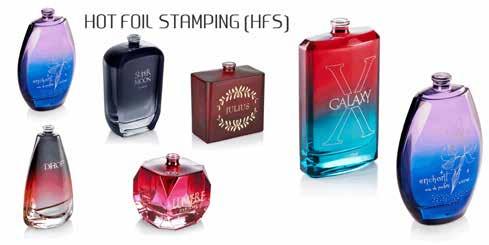
14 minute read
Cosmetic packaging trends
Ready for a close-up
cosmetic packaging growth continues
Rohan Gunasekera looks at how the cosmetic and personal care markets of the sub-continent are doing their best to absorb some of the excess container glass capacity in the region and provide a new market for innovation going forward…
India may no longer be the world’s fastest-growing major economy, but the sheer size of the country, young population and rising incomes indicate high growth prospects for cosmetics and perfumery, and with it glass packaging. Given the rate at which the cosmetics and perfumery market has been growing recently, there seems to be plenty of business for container glass manufacturers. Recent investments by container glass majors, both foreign and domestic, indicate the potential. Nevertheless, an immediate increase in cosmetic and perfumery glass packaging capacity is unlikely as excess capacity built up from previous bouts of expansion and market slow downs need to get absorbed.
Indian glass major Piramal Glass has announced plans for a big investment to expand production at its plant in Kosamba, western India, and also decoration facilities to supply premium perfume markets, which are growing fast. It is adding three more production lines to meet growing demand. Germany’s Heinz Glas has set up a joint venture with India’s Haldyn Glass called Haldyn-Heinz Fine Glass which is expanding capacity. And Hindusthan National Glass & Industries Limited is relining its furnace for making cosmetic glass.
There are many market studies and forecasts that say the cosmetics and personal care industry is one of the fastest growing consumer products sectors in India. The Indian beauty and personal care industry is estimated to be worth USD 8 billion and India’s per capita spend on beauty and personal care is growing in line with India’s GDP growth.
Overall, the market is seen moving towards premiumization, with premium segment growing faster than the mass market. Indian brands (both regional and national) have a sizeable presence in the mass category, while premium markets are largely dominated by the international brands. Factors expected to drive the market for beauty products include the trend of growing consciousness about grooming, with half of the rural population aged below 25 years. With increased awareness, the rural lifestyle and habits have started mirroring urban aspirations and lifestyle and this has brought about a shift from homemade solutions to branded products.
ASSOCHAM, the Associated Chambers of Commerce of India, noted in a market study that in current times, innovative packaging is playing an important role in driving sales of cosmetics, with multinationals preferring to use environment friendly packaging material. In case of men’s fragrances, it notes, innovative bottle designs hugely influence purchase. Further, pressure to manage costs, enclose products in a way that increases shelf-life, reducing tampering, confirmation that the items are not counterfeit, and showcase products in an appealing manner continue to drive demand for innovatively packaged organic cosmetics across the country.
With cosmetic glass containers highly challenged by alternatives in plastics and metals, the market is seen moving towards highly innovative products including lightweight, breakage resistant and intricately decorated alternatives. Cosmetic glass container market is dominated by premium perfume segment, which is the main driver of increasing demand. Smaller pack sizes are gaining preference over the conventional large size bottles owing to the increasing trend towards easy to carry pocket-sized bottles, for reasons like affordability and as they can be consumed before the expiration date. Small size bottles relatively have a better shelf appeal compare to large size bottles particularly in personal care and premium cosmetics segments where aesthetics plays a vital role. For glass bottles and jars, one of the major trends has noticeably been within decoration techniques, in particular the use of coloured glass.
Major growth Indian container glass major Piramal Glass Ltd. is expanding capacity in a big way, aiming to grow very fast in the next 3-5 years and be one of the top three players globally, said Prasanta Mohanty, the company’s Global Chief Marketing Head ( C&P ).
“Today, we have glass capacity of 700 tonnes per day dedicated to cosmetics and perfumery. We are investing about 30 million US dollars in expanding our decoration facility and glass production capacity dedicated to cosmetics and perfumery,” he told Asian Glass in an interview. “We doubled our capacity in decoration, with the new capacity already operational while the new glass production capacity will be available by mid-May 2020.”
Total capacity of glass dedicated to Cosmetics and perfumery will be increased
by 40 tonnes (almost six percent) – from 700 tonnes to 740 tonnes a day. One of the furnaces (with 100 tpd) in Kosamba plant, in the state of Gujarat in India will go for relining in mid-February and will become 140 tpd after relining – this new capacity will be available by mid May this year. Total tonnage at Piramal Glass plants, which also serves the food and beverage and pharmaceutical markets, apart from supplying perfume glass bottle markets across the globe, is now 1,360 tonnes a day. Piramal Glass has two plants in India, one plant in USA and another one in Sri Lanka.
Piramal Glass expects its sales of glass containers to cosmetics and perfumery segment to increase by almost 10 percent to close at 145 million US dollars in the financial year ending 31 March 2020, from 132 million US dollars a year ago, Mohanty said.
The total value of the global glass packaging market for cosmetics and perfumery, which includes perfume, nail polish, skin care and foundation, is around 2.1 – 2.2 billion US dollars. The cosmetics and perfumery retail or end-product market size, when the containers are filled with perfume and other products, could be 55 to 60 billion US dollars. Growth is coming from the luxury and premium segments of the perfumes glass bottles with the mass market segments either stagnant or shrinking slightly, Mohanty said. Globally, the overall perfume market is growing by 1.3 - 1.7 % with luxury perfume brands growing at about 4 to 5%.
In India, there is a marked shift in consumer preferences that augurs well for container glass manufacturers. “The Indian market was not a perfume market earlier. People used body sprays. But gradually we’re observing a shift to perfumes,” Mohanty explained. “We see many people have started wearing perfumes and many
companies have started filling perfumes in India for the local market. So there is a shift in the Indian market from body spray aerosols to perfume. The perfume business in India has just started growing. Growth is slow now but looking to the population of India, future prospect is very high.”
Piramal Glass also engages in a lot of innovation in glass bottle design, given the importance of the look and feel of packaging in perfume buying decisions. “There’s a lot of innovation happening in packaging in the luxury and premium brands and in decoration of glass bottles which plays a very important role in perfume sales,” Mohanty said. A notable example was the launch of Idôle, Lancôme’s newest fragrance, in a bottle made by couple of European glass manufacturers at the Luxury packaging exhibition ( Luxepack) in October 2019 in Monaco, a very thin and very high quality glass container promoted as the world’s thinnest fragrance bottle.
“Perfume bottles need good aesthetics, good decoration because the packaging is the first thing that attracts a consumer – the shape of the bottle, its design,” Mohanty said. “Only then the consumer tries the perfume inside, unless it’s a known brand name. So one has to come up with new designs all the time.”
Piramal Glass itself offers 50 to 60 new glass bottle and jar designs for perfume and skin care and 40 to 50 new glass bottle designs for nail polish to the market every year, apart from doing customised designs.
“We have our own design office where we create our own designs,” Mohanty said. “Also, we installed a new rotary machine recently which can produce glass bottles with 300 grammes plus weight with a very thick heavy bottom, with good aesthetics, uniform glass distribution and where the MOQ (Minimum Order Quantity) can be lower. We do fire polishing and grinding and

polishing, on customers’ request, of bottles to enhance the aesthetics and surface finish. We’ve positioned ourselves very well. We produce premium perfume glass containers for customers like Coty, Loreal, LVMH, Puig, Yves Rocher, Sisley, Ajmal, J&J, Revlon, Avon etc to name a few.”
A new trend in cosmetics and perfumery packaging is post-consumer recycled glass containers or external cullet in glass bottle manufacturing. “Today, because of environmental concerns, customers are asking for post-consumer recycled glass, whereas previously they insisted on virgin glass,” said Mohanty.
Back from plastic Globally there is also a reverse shift from plastic packaging to glass, partly owing to environmental concerns stemming from inadequate disposal of plastic waste as well as greater awareness of the benefits of the inert nature of glass to store perfumes and cream versus the risks of some contamination from materials like plastic. Mohanty said competition from plastics is diminishing in cosmetics and perfumery sector. “Today, people are trying to move from plastics to glass. For example, in skin care where there were some plastic jars, now customers are coming back to glass. So we see a reverse trend.”
The threat from glass container imports has also lessened in cosmetics & perfumery segment. “Some Chinese manufacturers used to export glass containers to India,” Mohanty said. “Many customers used to buy glass bottles for perfume from China because of cheaper price. Now because of environmental concerns in China, many glass companies have to shut down their production facilities. So there’s not much imports of glass bottles for cosmetics and perfumes in India now.”
Piramal Glass intends to continue expanding capacity to meet growing demand in the domestic and export markets with more capacity additions planned in the years ahead.
“We plan to expand again next year when a new furnace will be coming up,” said Mohanty. “We have expansion plans for the next 3 -5 years. We’re aiming to become one of the top three glass players globally in cosmetics and perfumery segment.”
Hindusthan National Glass & Industries Limited, India’s largest glass manufacturer, has a dedicated furnace for making cosmetic glass which has been just shut down for relining and ‘debottlenecking’ which should yield some incremental capacity improvement. Its capcity is 130 tonnes a day which could increase to around 150 tonnes or so when the relining is over in the next couple of months.
Vinay Saran, President, Marketing at Hindusthan National Glass & Industries Limited (HNGIL) said that in India the market for cosmetics and perfumes is growing fast, so packaging is also growing. “We have a cosmetic glass furnace, which is now down for relining and debottlenecking,” he told Asian Glass magazine.
“Growth in glass packaging is coming mainly from rising disposable incomes and growing consumer awareness, especially owing to the spread of e-commerce. More people are becoming aware that perfumes are going to be affordable. E-commerce makes it more affordable, compared to earlier when many people could not afford to buy perfumes. That’s what is expanding the market. Also, perfume is one segment where new designs are paramount. Consumers want new products. After some time nobody wants to buy the same thing over and over again.”
HNGIL estimates India’s cosmetics and cosmeceutical market will register annual growth of 25 % touching USD 20 billion by 2025 from present USD 6.5 billion from a global market of USD 274 billion. “Principal areas that are expected to grow include colour cosmetics, fragrances, specialised skin care and make-up cosmetics,” the company told shareholders in its annual report. “The Indian industry is growing rapidly at a rate of 13-18 %, more than that of US or European markets. Body care is the largest category and growing at about 4 % CAGR while colour cosmetics was the fastest growing category, at 12 %. The premium segment is expected to grow at 6.3 % per annum.”
COSMETICS AND TOILETRIES ARE ONE OF THE FASTEST GROWING CONSUMER PRODUCT SECTORS IN INDIA
Consumer power Pragati Glass Pvt. Ltd. President H.R. Bhandari said the market for cosmetic glass, estimated at around 90-100 million US dollars, should grow steadily as the economy grows, enhancing consumer purchasing power.
Before India opened up her economy in the late 1990s, cosmetics were considered a luxury product on which there were high government taxes that limited growth. “Since then, the economy has been growing and people have more buying power to buy cosmetic and perfumery,” Bhandari told Asian Glass in an interview. “At the same time, India started making container glass and also exporting.”
Pragati Glass, based in Mumbai, focuses on making container glass for cosmetics and perfumery with a dedicated furnace capacity of 130 tonnes per day. Almost 75 percent of total company production is for cosmetics and perfumery. The firm also has a plant in Oman with one furnace with a capacity of 135 tons per day.
Bhandari said that while the market is growing he does not see any immediate expansion in capacity for cosmetics and perfumery in the container glass packaging industry. “We had a lot of excess capacity in India a few years back,” he explained. “As demand grows, that surplus capacity is being absorbed. So for now, further investment in glass container capacity will be limited. That will take more time. For now, whenever someone goes for relining of a furnace, they might increase capacity. But green field investments are unlikely in the immediate future.”
Pragati Glass not only makes the glass packaging for cosmetics and perfumery but supplies the full service, that includes meeting a customers entire requirement, such as caps, pumps, labels and cartons. “We not only make glass bottles but also offer them (customers) the entire project,” Bhandari explained. “When someone needs glass containers for cosmetic, they also need caps, pump, labels and cartons, which we can supply in-house.”
Pragati Glass also has its own in-house design facility with services like frosting, colouring and printing. “Depending on market demands, we keep on making different sizes and shapes of bottles,” Bhandari said. “Cosmetics glass business is not volume-based, especially the perfumery business, unlike other segments like food and beverage where orders are placed for millions of bottles. For cosmetics, orders are for a few hundreds of thousands and we keep on changing shapes and sizes of bottles, especially for mid-level cosmetics makers.”
The Haldyn Glass joint venture with Heinz Glas was for manufacture and marketing of clear glass containers for the cosmetics and perfumery industries in India and abroad and part of the firm’s diversification effort. The joint venture
company in which Haldyn and Heinz have equal shares will manufacture glass flacons for the perfume and cosmetics industry with technical support from Heinz. The JV company has said it has been able to achieve European standards export quality in the initial period of operation. It also commissioned its decoration plant in March 2018. Carl-August Heinz, owner and CEO of Heinz Glas, has said the Indian market was growing steadily with potential to be the largest market in the world for perfumes. A fourth line could be added to the Indian glass factory with one furnace and three lines.
Bhandari of Pragati Glass estimates about 60-70 percent of Indian cosmetics glass production is exported and the rest used in-country. The main export markets are developed countries like Europe and United States. Exports also go to South American countries and also to African and Asian countries. Bhandari expects more growth from developing countries as their econmies grow and peoples’ buying power increases.
Unlike in other segments of container glass packaging, the threat from

cheap imports such as from Chinese suppliers is not there in cosmetics glass. “For cosmetic and perfumery glass, we don’t think we have any threat from the Chinese,” said Bhandari of Pragati Glass. Although there is some import from China, especially by perfume makers bottling in India who ship bottles from China, this is limited.
Plastics are also not seen as much of a threat in cosmetics and perfumery packaging, although in the overall market for beauty products, including hair and skin care, plastic does dominate. “In perfumery, I don’t think there is any conversion into plastic,” said Bhandari of Pragati Glass. “The premium products are all in glass. We don’t have any threat of plastic taking market share from glass.”
Said Saran of HNGIL: “In perfumes, use of glass is bigger. Although plastics does grow market share in certain segments, there appears to be a shift in consumer preferences as awareness grows of the advantages of glass. It’s not that big for cosmetics and perfumes in India yet, but there’s a perceptible change in consumer mind set. For instance, nobody wants premium perfumes in plastic bottles.”








